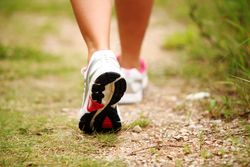
Running and jogging are accessible exercises that boost your cardiovascular health and help you enjoy the outdoors. As with any physical activity, it’s important to take safety precautions. Otherwise, you risk joint injuries, foot pain, and other conditions that could sideline you for weeks or months. If starting a running program was on your list of resolutions for the new year, use the guidance to protect yourself and ensure you get the most from your miles.
Do:
Start slow.
No matter what shape you’re in, it’s best to start slow when starting a new activity. Adding too much speed or distance too soon could lead to shin splints, knee pain, and a tight iliotibial band. Speak with your doctor about your planned exercise regimen, especially if you have existing joint injuries or medical conditions. They’ll evaluate your gait and advise on proper technique and ways to prevent injuries. When you head out for your first workout, take your time. Jog a casual mile first, taking breaks to walk as needed. Gradually work your way up to longer, more intense runs.
Buy the right shoes.
 Shoes are the most important piece of equipment when running. They provide cushioning to protect your joints from the impact of running, support your feet and ankles, and give you traction to avoid slipping. They should fit snugly but comfortably, leaving a little room at the toes. If you have flat feet, it’s especially important to find shoes with enough structure to prevent overpronation. Trot around the store to test them out and pay attention to how your foot strikes the ground to ensure you have the right pair for your running style.
Shoes are the most important piece of equipment when running. They provide cushioning to protect your joints from the impact of running, support your feet and ankles, and give you traction to avoid slipping. They should fit snugly but comfortably, leaving a little room at the toes. If you have flat feet, it’s especially important to find shoes with enough structure to prevent overpronation. Trot around the store to test them out and pay attention to how your foot strikes the ground to ensure you have the right pair for your running style.
Don’t:
Forget to warm up and stretch.
You can have the right shoes and technique, but if you forget to stretch, you’ll lower your performance and increase the risk of soreness and joint injuries. Warm up slowly and fully before each workout by jogging lightly in place, circling your arms, or opening your hips. After your workout, stretch for roughly 10 minutes to loosen muscles, ligaments, and tendons.
Limit your training.
Running is an excellent cardio workout, but it’s important to strengthen your muscles both for superior performance and injury prevention. Incorporate body weight exercises or weight lifting into your exercise routine. Don’t limit your activity to solo jogs. Running with a group will cultivate motivation and healthy competition. Plus, more experienced runners will offer tips on proper gait and mileage schedules.
If you’re a runner dealing with frustrating joint injuries or foot pain, turn to Orthopaedic Associates of Rochester. Located in Rochester, NY, their skilled staff will assist with sports injuries and general pain, as well as hip, knee, and foot surgery. They offer individualized attention and state-of-the-art techniques to build customized treatment plans for patients of all ages. Call (585) 723-3000 to schedule a consultation. Visit their website to learn more about their practice.
About the Business
Have a question? Ask the experts!
Send your question

